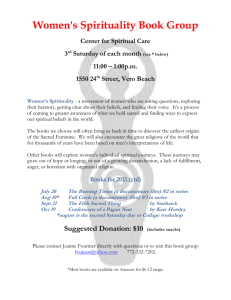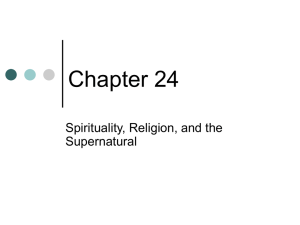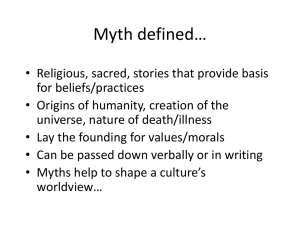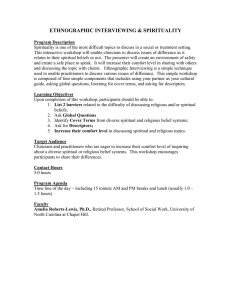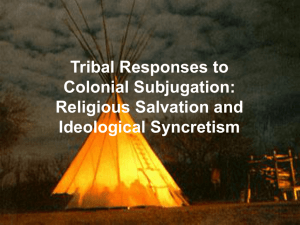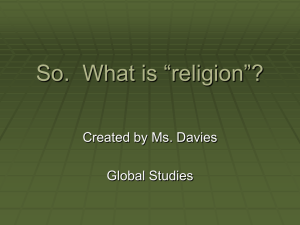Haviland_Cultural 13.ppt
advertisement
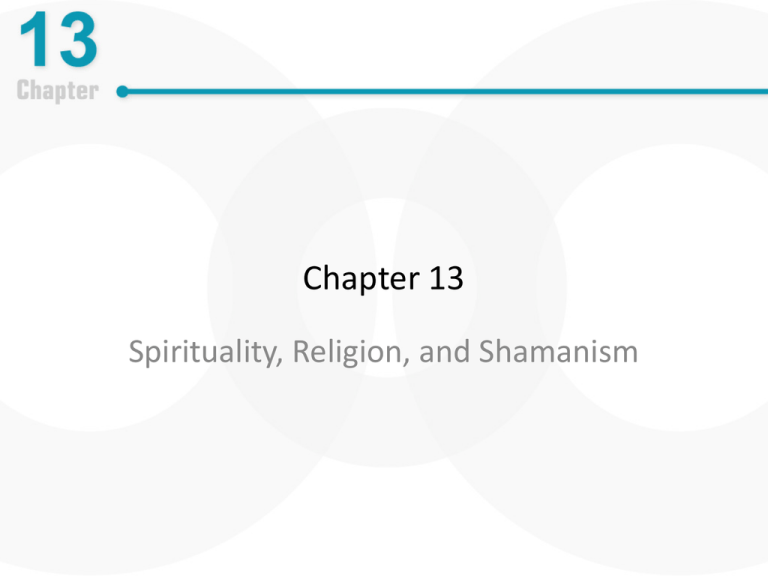
Chapter 13 Spirituality, Religion, and Shamanism What Will You Learn? • Articulate how religion is related to other parts of a cultural system • Distinguish a cross-cultural variety of supernatural beings and spiritual forces • Compare rituals • How do religions legitimize spiritual leadership • How does a place become a sacred site • Beliefs in evil, magic, witchcraft • Interpret shamanic healing and why it is effective • Analyze the connection between cultural upheaval and new religious movements Religion & Spirituality • Religion plays an important role in determining cultural identity in many societies. • Both spirituality and religion are considered to be apart of a cultures superstructure. • A cultures religion and spirituality can be examined in light of their worldview – the collective body of ideas that members of a culture generally share concerning the ultimate shape and substance of their reality. Roles of Spirituality and Religion • Religion and/or spiritual practices are to fulfill numerous social and psychological needs • Reduce anxiety • Path for people to transcend the burdens of mortal existence • Reinforces community values and moral guidelines • Offers narrative and rituals used to conform a social hierarchy • Sanction Power • Assist in reaching a specific goal Major Religions of the World • Do any of these statistics surprise you? Why or why not? Global Distributions of Predominant Religions Anthropological Approach to Spirituality and Religion • Religion is best defined in anthropology as an: – Organized system of ideas about the spiritual sphere or the supernatural. – Often has associated ceremonial practices by which people try to interpret or influence aspects of their universe. Spirituality • Similar to religion, spirituality is concerned with the supernatural as well. – It is distinguished from material matters. – Often individual as opposed to religion which is collective in nature. – Does not require organization. Myth and the Mapping of a Sacred Worldview • Myths are sacred narratives that explain the fundamentals of human existence-where we and everything in our world came from, why we are here, and where we are going. • A hallmark of religion is the belief in spiritual forces and supernatural beings. • Typically myths involve these supernatural forces or beings. Monotheism • The belief in only one supremely powerful divinity as creator and master of the universe. • What religion is an example of Monotheism? Polytheism • Polytheism, the oldest known religious belief pattern is the belief in several gods and/or goddesses. • What religion (past or present) is an example of polytheism? • Pantheon – several gods and goddesses of a people. Ancestral Spirits • A belief in spirits brings about a deeper belief in the flesh body actually consisting of two entities. • This might often be referred to as a soul. • The belief in ancestral spirits is commonly found around the world most often with unilineal descent patterns. • Ancestors might be worshipped, be thought to bring good or poor fortune, and make major decisions in the lives of the living. Animism • A belief that nature is animated (energized) by a distinct personalized spirit beings separable from bodies. • Thought to be the first form of religion. • These spirit beings are closer to humans than gods and goddesses and are concerned with human activities. • Animism is typical of peoples who see themselves as a part of nature rather than superior to it. Animatism • Animatism is a belief that the world is animated by impersonal supernatural powers. • Unlike animism, the form of power is ambiguous it does not take a particular shape, emotion, etc. • Often found in similar cultures where animism is found. Religious Specialists • Most cultures include individuals who guide and supplement the religious practices of others. • Religious specialists hold specific rights to contact and influence supernatural beings and manipulate supernatural forces. • They will have undergone special training and may display certain distinctive personality traits that make them particularly well suited to perform these tasks as determined by other group members. Priests and Priestesses • These are full-time specialists who have been formally recognized for their role in the guiding of religious practices for others. • He or she is the socially initiated, ceremonially inducted member of a religious organization. – Examples include: priest, minister, imam, lama, rabbi, etc. Priests and Priestesses • Spiritual lineage - a principle of leadership in which divine authority is passed down from a spiritual founding figure, such as a prophet or saint, to a chain of successors. Shamans • A shaman is considered a part-time specialist who may enter into an altered state of consciousness to contact and utilize an ordinarily hidden reality in order to acquire knowledge, power, and to help others. • Skilled at contacting and manipulating supernatural beings and powers through altered states of consciousness. • Provides a focal point of attention for society and can help maintain social control. • Benefits for the shaman are prestige, wealth, and an outlet for artistic self-expression. Shamanic Experience • One can become a shaman by passing through stages of learning and practical experience. • May include psychological and emotional ordeals such as isolation, fasting, physical torture, sensory deprivation, and/or hallucination. Shamanic Healing • Since a shaman is a spiritual go-between who acts on behalf of some human client, often they can bring about healing and foretell the future. • Upon entering into a trance then can see, interact, and impose their will onto spirits. Ritual Performances • Rituals are culturally prescribed symbolic acts of procedures designed to guide members of a community. – Personal or collective transitions • Taboos or a prohibition, which, if not observed, leads to a penalty inflicted by magic, spiritual force, or religion. • When a taboo is violated, believers expect supernatural punishment will follow. Rites of Purification • Rites that establish or restore purity. • May involved one person, but usually group or community affairs. • Symbolic act with spiritual or religious meaning. – Cleansing by water such as in a baptism is an example of this. Rites of Passage • Rites of passage that individuals may enter at differing times in their lives. These ritual stages mark important periods in ones life such as birth, marriage, and death. • Important to note that men and women may have differing rites of passages. • It is useful to examine rites of passage by breaking them down into three stages. – Separation – Transition – Incorporation Rites of Passage • Separation- the ritual removal of the individual from society. • Transition- isolation of the individual following separation and prior to incorporation into society. • Incorporation- reincorporation of the individual into society in his or her new status. Critical Thought • Identify in what ways a western marriage is a rite of passage? • Identify the separation, transition, and incorporation of this passage? Rites of Intensification • Rites of intensification which is a ritual that takes place during a crisis in the life of the group and serves to bind individuals together. • Does not have to be limited to times of crisis. • In regions where human activities change along with the seasons they can take the form of annual ceremonies. Magical Rituals • Magic- specific formulas and actions used to compel supernatural powers to act in certain ways for good or evil purposes. • A possible way to gain control over uncontrollable situations; good crops, fertility of livestock, replenishment of hunted game, prevention of accidents, healing of illness, protection, etc. Magic • Imitative magic (sympathetic magic) – Magic based on the principle that like produces like. • The use of voodoo dolls would be an example of this. • Contagious magic – Magic based on the principle that things or persons once in contact can influence each other after the contact is broken. • The usage of fingernail clippings or hair would be examples of this. Divination: Omens and Oracles • A method to prepare for the unknown and/or not yet present. • Divination- a magical procedure for determining the cause of a particular event, such as illness, or foretelling the future. – Do we practice this in our society? Witchcraft • Witchcraft is an explanation of events based on the belief that certain individuals possess an innate psychic power capable of causing harm, including sickness and death. • Serves to offer an explanation for events that can not otherwise be explained by the logic of the group. • Effective way for people to explain away personal misfortune without having to shoulder any of the blame themselves. • Provides an outlet for feelings of hostility and frustration without disturbing the norms of the larger group. Sacred Sites: Saints, Shrines, and Miracles • Thousands of people make pilgrimage to sights for religious purposes. • Geographical places usually hold significant meaning in the religion as an ancestral sight where an important event took place. • Burial locations can also be considered a sacred site. – Pilgrimage- a devotion in motion. Traveling often on foot, to a sacred or holy site to reach for enlightenment prove devotion, and/or experience a miracle. HAJI • World’s largest pilgrimage performed by over 1.8 million Muslims • Travel to Mecca in Saudi Arabia • Annually about 300,000 people from all over the world Desecration: Ruining Sacred Sites • Since shrines are built by believers they become potential targets by non-believers. • Desecration-ideologically inspired violation of a sacred site intended to inflict harm, if only symbolically, on people judged to have impure, false, or even evil beliefs and ritual practices. Revitalization Movements • As deliberate efforts to construct a more satisfying culture, revitalization movements aim to reform not just the religious sphere of activity but may also impact an entire cultural system. • Revitalization movements are great examples of religious change. They are characterized by social movements, often of a religious nature, with the purpose of totally reforming a society. Revitalization Movements • These movements can be in response to a widespread social disruption. • Often radical in nature they collect the societies feelings of stress and despair. • Surprisingly can be quite effective in the drastic change of the religion and the culture. Syncretic Religions • Syncretism is the creative blending of indigenous and foreign beliefs and practices into new cultural forms. • Vodou is an example of a syncretic religion as it combines both Christian and African belief systems. Religious Pluralism and Secularization • Secularization is a process of cultural change in which a population tends towards a nonreligious worldview, ignoring or rejecting institutionalized spiritual beliefs and rituals. • More common among wealthy industrialized societies such as the United States and many Western European countries.
